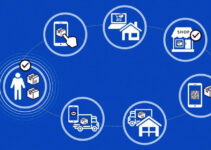The supply chain comprises of series of activities and processes that companies employ to deliver quality products and services to the customers. Manual processing of various roles and functions amplifies the probability of human error and consumes a lot of time and resources. On the other hand, digital technology helps them to perform various functions efficiently. Today, we’ll discuss E-supply chain management; its definition, key elements, and benefits of SCM.
What is E-Supply Chain Management?
E-supply chain management is the method of employing the latest digital technology to manage and optimize various SC activities and processes. It ranges from sourcing the raw material, production and manufacturing, and delivering the finished goods to the customers
E-SCM employs data-sharing technology and electronic communication among SC partners, retailers, distributors, manufacturers, and suppliers. The usage of the latest technology helps the company to amplify the customer satisfaction level, low cost, high efficiency, collaboration among SC processes, and real-time transparency and visibility. However, some of the technology the company employs is as follows;
- IoT (internet of things)
- Data Analytics
- Cloud computing
Technological development is replacing traditional business processes and activities, and the E-SCM is the outcome of advanced technology. E-SCM is the integration and combination of business applications that automate various SC activities and processes. You can develop it by integrating the following tools and applications;
- E-business
- E-billing system
- And e-procurement system
E-SCM allows SC team members to manage delivery time, cost, quantity, and specification of the products and supplies. It amplifies the efficiency and effectiveness of distribution, production, logistics, and other SC activities. However, it facilitates various processes of the company ranging from product design, sourcing, procurement, distribution, warehousing, and delivering the finished goods to the end consumers.
Element of E-SCM
Some of the main components and elements of E-SCM are as follows;
E-Procurement
It employs web-based technology to facilitate key procurement activities and processes like payment, ordering, contracting, sourcing, and requisitioning. The E-procurement process facilitates the procurement of both direct and indirect material and employs various web-based functions like the following;
- Shipping Notice
- Purchase order
- Contracts
- Online catalogue
SC Replenishment
SC replenishment comprises combined production and distribution processes. Businesses and companies utilize the replenishment information to take the following steps;
- Synchronizing supply and demand information
- The high velocity of replenishment
- Removing stocking points
- Low Inventory
Collaborative Planning
It is a form of business strategy that integrates business knowledge and forecast with the supply chain to amplify the fulfillment and planning of customer demand. It needs sellers and buyers to establish a shared demand forecast and SC plans on how to facilitate the demand.
E-Logistics
It employs the latest web-based technology to facilitate transformation processes, warehousing, and material acquisition. It allows the distribution system to optimize route planning with inventory tracking information.
Product Design & Development
It comprises employing development strategies and product design across multiple companies to decrease the time to market and increase the product launch success. You can share the design drawings through a secure network while product development and engineering with the following;
- Service companies
- Downstream manufacturing
- Marketing team
- Testing facility
- Contracting Company
Order Commitment
E-SCM helps businesses and companies calculate the delivery time and date of the suppliers and vendors through the demand fulfillment cycle. Companies could integrate order commitment with the rest of the SC unit to ensure the timely delivery of products and services.
Transportation Planning
E-SCM supports the distribution of resources to ensure the delivery of supplies and finished goods to the right people at the right time in the right place. It streamlines processes with a planning schedule. However, it allows you to compare the availability of transportation modes like airlines, railways, and trucks. It is highly beneficial to the companies in finding the most suitable mode of transportation for delivering raw supplies and finished goods.
Demand Forecasting
E-SCM offers you a variety of tools and applications for demand planning and forecasting. Companies could employ such tools and strategies to predict logistics, capital, labor, and raw supplies that the company would require to satisfy the sudden increase in demand.
Benefits of E-SCM
Some of the main benefits of E-SCM are as follows;
- Data consistency amplifies the back-office management
- Internet connects suppliers and distributors and manages inventory of the relevant information that you can replenish at the most appropriate and suitable time
- Provides access to the information and speedy response time
- It amplifies the company’s capability to analyze the cost-effective supplier of raw material
- Better control over SCM processes
- Decreases cost of distribution, procurement, production, and logistics
Conclusion: E-Supply Chain Management
After an in-depth study of e-supply chain management; we have realized that E-SCM is highly significant to modern business operations and processes. If you are learning about E-SCM, then you should keep in mind the abovementioned elements and benefits.
Ahsan is an accomplished researcher and has a deep insight in worldly life affairs. He goes Live 3 days a week on various social media platforms. Other than research writing, he’s a very interesting person.


